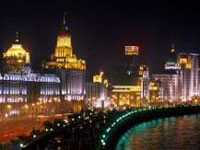Overview Vietnam
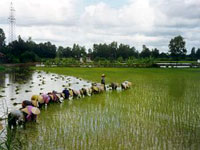
Rice planting © Judith Duk
Verdant patchworks of rice paddies, pointed lampshade-style hats, a country ravaged by war, and economic repression - these are the international images of Vietnam, seen on worldwide television and read about in the newspapers. But there are other scenes to be found, ones of natural beauty, ethnic culture, and imperial history, of timeless traditional villages, idyllic sea resorts and dynamic cities.
Shaped like an elongated 'S', Vietnam stretches along the east coast of the Indochinese Peninsula and is likened by its people to a long bamboo pole hung with two baskets of rice, represented by the two fertile regions at either end of the country. Between the lush Red River Delta and the highlands in the north, known for their magnificent scenery and colourful hill tribes, and the agricultural plains and floating markets of the Mekong Delta in the south, lie miles of white sandy beaches, towering mountains, rivers and dense forests, and the thousands of bizarre rock and cave formations on the islands of Halong Bay.
The impact of Japanese and Chinese trade, French occupation and American intervention has left its stain on Vietnam, smeared over a period of more than two thousand years of recorded history. However, the country has also been left with a vivid legacy from different cultures evident in the character of its towns, as well as in the architecture and food. The quaint town of Hoi An, once a major trading port, boasts the perfectly preserved architectural influences of the Asian merchants from the north, while the broad leafy boulevards of the capital Hanoi and Ho Chi Minh City are reminiscent of France. Menus offer Chinese variations of spring rolls, steamed dumplings and noodles. Hué is the old imperial capital of Vietnam with its royal palaces and palatial mausoleums, and nearby the battle sites of the Demilitarised Zone (DMZ) are reminders of the brutality of war.
Ancient temples and colourful pagodas are scattered throughout the urban centres, while among them stand hotels of modern luxury, and the development of tourism infrastructure is a booming business. Vietnam is a perfect balance between ancient times and the here and now, a country that reveres its past heroes, a nation that has collectively put the woes of war behind it, and people who welcome visitors to their country with open arms and friendly smiles.
Ha Noi.
Why? Visitors to Vietnam should not miss out on a holiday in Hanoi, the 1,000-year-old capital, a low-rise city of lakes and peaceful parks. A Hanoi holiday is a pleasant, unhurried experience of exploring the historic Old Quarter with its arts and crafts bargains, and strolling the streets of the French Colonial sector.
When? Situated in northern Vietnam, Hanoi has hot and humid weather most of the year, with most of its rainfall falling between May and September (summer). The best time to holiday in Hanoi is between September and December, when humidity levels are lowest.
Who for? Travel to Hanoi is for serious travellers who are drawn to Vietnam to experience its beauty, wonderful food, friendly people and unique culture. The city is a great base from which to explore the surrounding countryside.
More Info : Know before you go on a holiday in Hanoi by consulting our comprehensive, up-to-date Hanoi travel guide. The guide is essential reading for anyone planning to travel to Hanoi, containing basic information like entry requirements, health and safety, as well as details of attractions and excursions.
Vietnam's small and pleasant capital lies at the heart of the northern Red River Delta, and is a city of lakes, leafy boulevards and open parks with a French colonial feel.
Hanoi was founded in 1010, and became the centre of government for the Indochina Union under French rule in 1888. In 1954 it became the official capital of independent Vietnam. Today ancient crumbling buildings dating from the 11th century lie scattered among grand French colonial residences, while shrines and monuments to Vietnam's first president, Ho Chi Minh, sit in the shadow of modern high-rise buildings. The streets of the Old Quarter preserve age-old customs, where trade takes one back half a century, and temples, pagodas and monuments reflect the historic character of Vietnam.
Although a city of historical importance, and the social and cultural centre of Vietnam, it is a surprisingly modest and charming place, far slower and less developed than Ho Chi Minh City in the south. Hanoi has retained its appealing sense of the old world, despite the onset of a brisk tourism trade in 1993, absorbing the boom of hotels, travellers' hangouts and Internet cafes, and the gradual infiltration of western-style food and fashions into the once inaccessible city.
As the early morning mist rises from the serene Hoan Kiem Lake, tracksuit-clad elders perform the slow movements of tai chi, like park statues coming to life. Streets become filled with activity, mopeds and bicycles weave among pedestrians, while cyclo drivers (three-wheeled bicycle taxis) clamour for attention, and postcard vendors cluster around tourists like bees sensing an open honey pot.
Hanoi is fast becoming one of the most enticing and interesting cities in Asia. As a cultural centre there are traditional water puppet shows, and music and dance performances. It is also a good base for excursions to the beautiful Halong Bay, or into the Hoang Lien Mountains inhabited by several hill tribes.
Ho Chi Minh City Travel Guide/
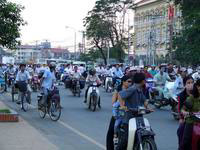 Why? Most people choose to holiday in Ho Chi Minh City (formerly Saigon) because it makes a perfect base for exploring the magical Mekong Delta, one of Vietnam's most popular tourist destinations. The city is, though, also legendary for its exuberant, muddled society, streets crammed with motorcycles and all sorts of entrepreneurial wonders. Travel to Ho Chi Minh City to discover the heart and soul of modern Vietnam.
Why? Most people choose to holiday in Ho Chi Minh City (formerly Saigon) because it makes a perfect base for exploring the magical Mekong Delta, one of Vietnam's most popular tourist destinations. The city is, though, also legendary for its exuberant, muddled society, streets crammed with motorcycles and all sorts of entrepreneurial wonders. Travel to Ho Chi Minh City to discover the heart and soul of modern Vietnam.When? The best time to holiday in Ho Chi Minh City is during the dry season between December and March, when it is also slightly cooler than it is during the rest of the year in this tropical city.
Who for? Anyone who is fascinated with Asian culture and history, and particularly stimulated by the energy of a major Asian metropolis, will enjoy a holiday in Ho Chi Minh City.
More Info: If you intend to travel to Ho Chi Minh City it is wise to print out our comprehensive Ho Chi Minh City travel guide, which is packed with useful information. The guide explains currency regulations, entry requirements, duty free allowances and all sorts of other practical matters, as well as listing attractions and excursions to enjoy during your Ho Chi Minh holiday.
Ho Chi Minh City, better known by its former name of Saigon, is a brazen, industrious and dense metropolis, the largest city in Vietnam and the business capital of the country. With a population of five million, it is crowded, noisy and dirty, yet it is also exciting and historic, the essence of the nation.
Located on the Saigon River on the edge of the Mekong Delta, Saigon became the capital of the Republic of South Vietnam and was the American headquarters during the Vietnam War. Two years later the Communist north took control of the country, the city's name was changed to Ho Chi Minh City, and recession and poverty ensued.
Today Ho Chi Minh City has a cosmopolitan and energetic atmosphere, and having actively welcomed the new capitalist principle, the business-minded spirit of the people is much in evidence. Although relatively modern, it has still managed to hold onto its Asian character, and fine restaurants, smart hotels and chic bars line the sidewalks crammed with noodle stands, markets and shoeshine boys. The buzzing of motorbikes and scooters merges with the cries of street vendors and the urgent business of stall owners, selling barbecued dog, writhing snakes and tropical fruits. The sight of a family of four balanced precariously on a scooter, a squealing pig strapped onto the back of a bicycle, bowed heads topped by pointed lampshade-style hats and orange-clothed monks are just some of the vibrant images the city has to offer.
Although overshadowed by modern and Asiatic influences, a little of Ho Chi Minh City's French colonial charm still remains, evident in the graceful architecture, wide boulevards, and a sidewalk cafe society. It is not for the attractions that one visits Ho Chi Minh City however, but for the vibrancy of its street life, and its proximity to the Mekong Delta.
Geographical Location and Climate
 Halong Bay is located in the Northeast of Vietnam, belonging to QuangNinh Province. It is in the coastal area stretching from 1060 56’ to 1070 37’ east longitude and 200 43’ to 210 09’ north latitude. To the west and northwest, Halong Bay stretches from Yen Hung District, and includes the large urban areas of Halong City and Cam Pha Town, as well as Van Don Island District. To the south and southeast, it is adjacent to the western Tonkin Gulf and to the west and southwest lies Cat Ba Island in the province of Hai Phong. On the world map, Ha Long Bay borders to China in the north and in the east it is adjacent to the East Sea.
Halong Bay is located in the Northeast of Vietnam, belonging to QuangNinh Province. It is in the coastal area stretching from 1060 56’ to 1070 37’ east longitude and 200 43’ to 210 09’ north latitude. To the west and northwest, Halong Bay stretches from Yen Hung District, and includes the large urban areas of Halong City and Cam Pha Town, as well as Van Don Island District. To the south and southeast, it is adjacent to the western Tonkin Gulf and to the west and southwest lies Cat Ba Island in the province of Hai Phong. On the world map, Ha Long Bay borders to China in the north and in the east it is adjacent to the East Sea.  |
In 1962, the Ministry of Culture and Information classified Halong Bay as a National Landscape Site, covering an area of 1,553 km2 with 1,969 islands. Halong Bay has been recognized twice by UNESCO as a World Heritage Area for its universal values of landscape, geology and geomorphology, respectively in 1994 and 2000, an area of 434 sq. km. including 775 islands.
The area inscribed by UNESCO (the Protected Area I - the Core Zone) is bound by Dau Go Island in the east, Ba Ham Lake in the south and Cong Tay Island in the east. The Protected Area II - the Buffer Zone is identified by the shore of the Bay running along the National Highway No. 18A, from the Gasoline Warehouse B12 in Cai Dam Precinct to the km.11 marker in Quang Hanh Precinct, Cam Pha Town. The Protected Area III - the Hinterland Zone is the sea or mainland area surrounding the buffer zone, including the area adjacent to the Cat Ba National Park of Hai Phong City.
- Climate is featured humid tropical charactor, including two distinct seasons: hot, humid with much rainning in summer and cold, dry in winter. The average temperature ranges from 150 – 250C with annual average rainfall of 2,000 – 2,200mm/year. Halong Bay has a typical tidal time (tidal amplitude ranges from 3.5 – 4.0m. The degree of salt in the sea water ranges from 31 – 34.5% in the dry season and decreases in the rainy season.


============================================================================
Overview China
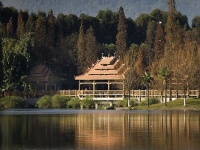
Southwest Kunming © babasteve
The People's Republic of China has been under communist government since 1949, but is currently undergoing social and economic development. Emphasis is being placed on tourist facilities and infrastructure. China is opening the doors to its wealth of historical and cultural treasures and visitors are flooding in to be amazed and awed. Organised tours are still the favoured way to explore China, but independent travel is slowly becoming easier. The major cities, like Beijing and Shanghai, are modern metropolises offering fast food and glitzy stores alongside centuries-old historical buildings and traditional eating houses. Archaeological wonders vie with amazing architecture in the interior, while majestic mountains and remote monasteries crown the northern areas.
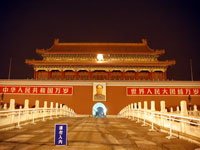 Beijing Travel Guide
Beijing Travel Guide
Why? To see China's most famous attraction, the awesome 'Forbidden City', travel to Beijing, the bustling Chinese capital. Beijing is the heartland of Chinese culture and politics, where historic sites and fascinating museums rub shoulders with glittering new skyscrapers.When? Now is a great time to holiday in Beijing, most of its attractions and tourist facilities have been overhauled for the 2008 Olympics. Weather-wise the best time to travel to Beijing is during the relatively short spring (February to April) or autumn (August to October), avoiding the stifling summers and freezing winters.
Who for? A holiday in Beijing is for the serious sightseer who wants to explore Chinese history and experience modern China.
More Info: Entry requirements, health, local customs and safety issues are all important factors when planning to travel to Beijing and details of all of these, and more, can be found on our comprehensive Beijing travel guide. There are also details of all attractions, events, and top restaurants in this fascinating city.The capital of the People's Republic of China, Beijing (formerly Peking) is a very modern and exceedingly busy city (nearly 14 million people call it home) with high-rise buildings, international hotels and sprawling suburbs. The city is abuzz and bristling with cranes on the skyline as construction projects give rise to new skyscrapers and modernisation proceeds apace. However, Beijing also encompasses numerous attractions of cultural and historical interest, of which some, such as the Great Wall, former Imperial palace (known as the Forbidden City), the Temple of Heaven, Summer Palace and the remains of Peking Man at Zhoukoudian, are UNESCO-endorsed World Cultural Heritage Sites. Chinese history and culture fascinates Western visitors, and Beijing is the place to start exploring it. The city abounds in imperial palaces, temples, mansions, gardens and tombs that epitomise classical Chinese architecture. It has 120 museums and more than 100 public gardens.
The first port of call for most visitors is the Forbidden City, which lies at the heart of Beijing with the rest of the city radiating out from it in a grid pattern. For five centuries this massive palace complex with 9,999 rooms functioned as the administrative centre of the country and home to a succession of emperors, who lived in luxurious isolation, surrounded by courtiers and retainers. The Palace overlooks the famous Tiananmen Square, site of so much political drama and dissent, the epitome of this capital city.
In preparing to host what they hoped were 'the best games in Olympic history', Beijing undertook many major renovations in 2008. Public transport was improved, environmental issues addressed and a general clean up of the city was orderes ordered. The Chinese saw the games highlight its economic rise and emergence as a world power.

